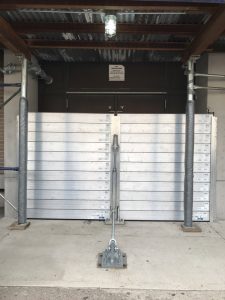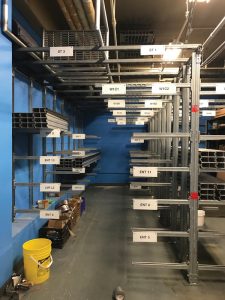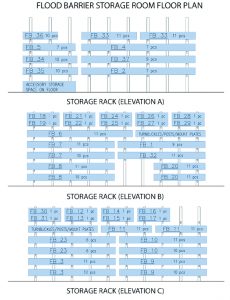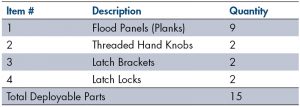Ways to Ensure Deployed Flood Barriers Work
Imagine spending millions of dollars on flood protection but, when a storm approaches, the deployable flood barriers cannot be installed in time. Learning from experience and adding some common sense helps reduce the risk of improperly deploying flood barriers. Storage, maintenance, and deployment execution are the primary considerations for barrier selection and must be vetted fully during preliminary and final design to reduce operational challenges. Labeling and storing components in a readily accessible position and having deployment plans that are well thought out promote the flood mitigation system’s overall success. Deployment-related risks can be decreased by minimizing the number of components assembled in the field.
Focus on the Workforce
Deployable flood barriers are workforce intensive; therefore, design teams should select these systems considering the emergency management organization responsible for the deployment and plan accordingly. Things might not always go according to plan in times of crisis or as seamlessly as factory testing implies. To mitigate this risk, the design team should consult the end user (e.g., the owner, operator, or staff deploying the flood mitigation system) to understand key variables such as workforce availability, time to deploy, and other logistics. If the deployment window is short, additional workforce may be necessary. This evaluation may also include a qualitative assessment of the end user’s capacity for robust training, accessibility of the site, and whether there is onsite personnel qualified to deploy the system in the face of an emergency. Without end user support, deployable flood barriers are rendered ineffective.

Robust training programs arguably are the most critical factor for successful deployment. At a minimum, an owner’s Flood Operation Response Plan should specify annual exercises that fully or partially deploy the system (Figure 1). The training frequency should also be customized to account for end-user staff turnover and the system’s complexity.
It is also vital to understand how much time is available, prior to a storm landfall, for deploying the flood barrier system. Site-specific temporal constraints leading up to a storm event inform the overall system’s design and influence the selection of barrier types. These constraints include but are not limited to storage locations and the workforce needed to deploy the system. Temporal variables should also be considered, such as the permitted duration of suspended facility operations (e.g., subways are taken out of service 2-6 hours prior to landfall depending on the line), the designated threshold for shut down of equipment (e.g., power down industrial processes), and the evacuation procedure for occupants. For example, a building may need to be fully evacuated at the time of deployment to facilitate the safety of building occupants. However, in some instances, the system may be partially erected while the building remains occupied.
The design team should also consider various workforce availability scenarios. For example, if janitorial staff deploy the flood barriers, will those same workers have other responsibilities during an emergency? Workforce availability may be impacted by inaccessibility to the site due to flood-related road closures or increased traffic resulting from evacuation orders. Ask: “If the workforce was limited to two workers, how many shifts would it take to deploy?” Conversely, if the workforce was tripled, is the time to deploy reduced by a third? The time to erect each component and the number of available workers should influence the number and type of deployable flood barriers, the overall timing of the closure, and the deployment sequence – all critical inputs to the Flood Operation Response Plan.
The design team must be cognizant that workforce availability considerations are not limited to the next event; instead, they are essential over the lifespan of the asset being protected. Therefore, the owner must commit to promoting workforce sustainability over the flood mitigation system’s lifecycle. For example, if a third party will provide operations support during an emergency, when will that contract expire? Will there be funding available for continued support post-contract expiration? Note that it is inherently riskier to rely on an outside entity to deploy flood barrier systems because there are many variables that an owner cannot control. For example, the third-party contractor may go out of business or have other commitments that could jeopardize the availability of a workforce at the time of deployment.
The design team can effectively deploy the flood mitigation system by incorporating logistics planning into the project’s conceptual phases. Using an intuitive order of operations, such as deploying the system counterclockwise around the subject building, will contribute to efficient deployment. If the storage of barriers is organized to facilitate counterclockwise deployment, the end user may find it easier to deploy. For example, one may choose to number the stored flood barriers in ascending numerical order corresponding to counterclockwise deployment.

In general, simple naming conventions for flood barriers (Figure 2) make it easier for the workforce to deploy to the proper locations without continually consulting a location map. It is helpful to label the opening (e.g., doorway) with a unique corresponding identifier. Other logistics-related value-adds include: consideration for a supply of battery-powered radios in case communication infrastructure (i.e., cell towers) is down when the system must be deployed, waterproofing the pages of the Flood Operation Response Plan and other essential documents, and including spray bottles filled with a water-dish soap mixture to lubricate the jamb seals or other edges that need to be slid into place in the field.
Engaging the end user early also has the added benefit of garnering stakeholder buy-in and impresses upon the end user the importance of training, organized inventory and storage, and proper erection of flood barriers. The design team should prioritize the Flood Operation Response Plan’s preparation as much as designing the actual barriers. Considering deployment constraints, capitalizing on site-specific attributes, and involving the end user in the design are vital to creating the right system for a particular client’s needs.
Intuitive Storage is Key
A well-conceived and organized storage system is key to the flood mitigation system’s operational success. Note, however, that every time the system is deployed, the likelihood of misplacing or losing pieces increases. For this reason, design of the storage space is fundamental to the success of the flood mitigation program.

Administrative items such as well-documented inventory lists, labels on both the components and the shelves (Figure 3), posted storage plans, and a clearly articulated process for reporting missing pieces contribute to an organized storage space. Spare parts are essential and should be specified as part of the design. If tools are needed to assemble flood barriers, standard tools, rather than proprietary tools, should be specified early in the design process. Tools provided by the manufacturer need to be included in the inventory and stored with the flood barrier system. An end user’s worst nightmare would be having all the components to deploy a flood barrier except the custom tool needed to assemble it. Store dollies or hand trucks ready for deployment, and in appropriate quantities, in the storage room.
Depending on how complex the flood mitigation system is, the design team may want to examine the most effective stacking procedures for components. An example flood storage diagram is shown in Figure 4. For instance, it may be beneficial to stack the segmental flood panels in the deployed orientation. That way, the user can off-load the parts onto the dolly or hand truck from top to bottom, then deploy them for erection (from bottom piece to top).

Beyond the storage room’s interior organization, the design team should also consider its proximity to the deployment location and travel path to the deployment location. If, for example, two workers must carry a segmental flood panel, the design should consider turning radii in corridors and pinch points along the route. In addition, the flood barrier storage location should be near the deployment site to reduce the travel distance.
If storage is not available onsite, many other variables should be considered. Determine the storage fee over the flood mitigation system’s lifecycle and manage the budget. Consider equipment rentals and availability or exclusivity of trucking agreements to reduce the risk of materials not being transported to the site on time. Detail the complete process for transport in the Flood Response Operation Plan.
Less (Parts) is More
Numerous flood barrier parts have the potential to prevent the successful deployment of flood mitigation systems. Deployable flood barriers have two general groupings of parts. The first is the main barrier pieces, whether a fabric or metal material that serves as the protective surface (the barrier). The second is the additional components needed to install, assemble, seal, and lock the barrier (the components). All parts should be stored securely and be identifiable and transportable to designated locations prepared to receive them for proper installation. Operational pitfalls associated with an increased number of parts include:
- Misplacement or loss of a component required to maintain barrier effectiveness/functionality
- Damage to parts during storage or deployment
- Restocking the parts incorrectly after a training exercise
- Errors in maintenance procedures or storage
- Faulty or incomplete deployment
Not being able to deploy a single flood barrier part may result in the entire flood mitigation system’s failure. Since manufacturers for individual products typically provide guidance to maintain and operate flood barriers, flood mitigation systems encompassing multiple products (especially if sourced from multiple manufacturers) require overarching operation and maintenance measures integrated into the Flood Operation Response Plan. This is key to minimizing the chance of pitfalls relating to individual parts while addressing potential conflicts and efficiencies for the system’s coherent and reliable operation as a whole.

Table 1 includes a hypothetical deployable parts list (15 total parts) for a segmental flood panel barrier for an approximately 8.5 feet wide and 4.5 feet tall opening.
The binomial cumulative distribution function (CDF), given by the following equation, may be used to approximate the probability of system failure, given a selected number of parts for which, if failure were to occur, would trigger an overall system failure.

Based on the following parameters:
M – total number of parts that can fail
N – total number of parts making up the system
p – probability of failure for a single part

The probability of failure of the segmental flood panel barrier under different scenarios is described in Table 2, where the assumed per-part probability of failure (p) varies. In Table 2, there are three conservative failure probabilities: 0.5% (1 incorrect deployment in 200 attempts), 1% (1 incorrect deployment in 100 attempts), and 2% (1 incorrect deployment in 50 attempts). The scenarios presented in Table 2 assume that each flood barrier part is mutually independent, equally essential to functionality, and equally likely to fail. This demonstrates how the probability of system failure increases as the number of parts in the system increases and how the probability of system failure decreases as the system becomes more resilient (e.g., greater redundancy or lesser interdependencies of components within the system).
Considering this data, selecting flood barriers with fewer parts, particularly for projects with multiple barriers, is always prudent. In cases where a barrier typology with numerous parts is selected, a thorough inventory and maintenance system should be developed, with schedules and parts lists, and communicated to the end user. Adequate planning and training can also reduce the probability of pitfalls associated with each part’s successful deployment.
Conclusion
This article identifies various ways to manage risk of failure of deployable flood barriers. Risks fall into three categories: parts, people, and storage.
Systems should be designed to limit human interaction where feasible. Designers should also work with manufacturers to reduce the number of operable parts per flood barrier and make the deployment procedures as easy as possible. While the flood mitigation system’s focus tends to be on the emergency condition, the end user will more likely operate it in a non-emergency condition (i.e., training exercises) during its tenure. Because of this, anticipate, at minimum, annual human contact with barriers that may result in operational pitfalls.
Designers should engage with the end user early and iteratively in the development process to address limitations or constraints such as workforce availability, workforce sustainability, training capacity, and off-site storage. Communicate those needs to the owner upfront and specify the Flood Response Operation Plan’s approach.
Lastly, do not underestimate the importance of well-organized storage. The flood mitigation system must be maintained and stored properly so that the system can be efficiently deployed in an emergency situation.
The design team’s responsibility is to provide a user-friendly, site-specific system that addresses the end users’ needs when successfully deployed in an emergency.■
References
American Society of Civil Engineers (ASCE) (2005). Flood Resistant Design and Construction. ASCE Standard 24.
ASCE (2010). Minimum Design Loads and Associated Criteria for Buildings and Other Structures. ASCE/SEI Standard 7-10.
Federal Emergency Management Agency (FEMA) (2013), Floodproofing Non-Residential Buildings. FEMA P-936.
FEMA (2013), Non-Residential Floodproofing – Requirements and Certification. National Flood Insurance Program (NFIP) Technical Bulletin 3-93.
International Code Council, Inc. (ICC) (2017), 2018 International Building Code (ISBN: 978-1-60983-735-8). ICC, Country Club Hills, IL.
New York City Department of Buildings (NYC DOB) (2014), New York City Building Code, Appendix G.
United Nations Office for Disaster Risk Reduction (UNDRR) (2019), Global Assessment Report on Disaster Risk Reduction, Geneva, Switzerland.
U.S. Army Corps of Engineers (USACE) (1995). Flood Proofing Regulations. Engineering Pamphlet EP 1165-2-314.
